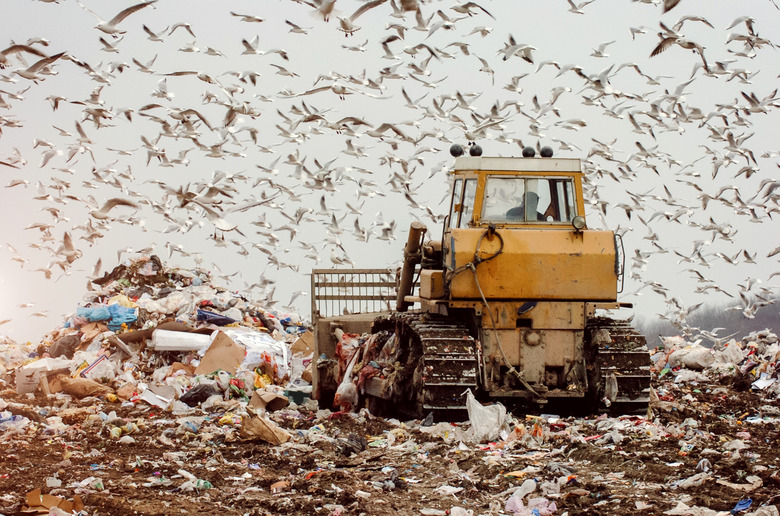Examples Of Secondary Pollutants
It's no secret that pollution is a pressing issue that deserves immediate attention. Toxic pollution affects more than 200 million people around the world, and ambient air pollution contributes to 5.4 percent of all deaths worldwide. Pollution kills more people than malaria, AIDS and tuberculosis combined. Pollutants are classified as either primary or secondary pollutants.
TL;DR (Too Long; Didn't Read)
Secondary pollutant form when primary pollutants emitted directly from a combustion process react in the atmosphere. Primary pollutants include ammonia, sulfur dioxide, nitrogen dioxide and carbon monoxide. Secondary pollutants include ground-level ozone, acid rain and nutrient enrichment compounds.
Ground-Level Ozone
Ground-Level Ozone
Ozone forms when hydrocarbons and nitrogen oxides combine in the presence of sunlight and stagnant air. It is a colorless, highly irritating gas with a sweet smell that forms just above the Earth's surface.
Burning coal, gasoline and oil in homes, motor vehicles, power plants and industries creates nitrogen oxides. Gasoline combustion, oil and gas production, wood combustion, and the evaporation of liquid fuels and solvents create hydrocarbons. They also come from natural sources such as coniferous forests.
Ozone exposure may cause premature mortality and major health issues. It also affects vegetation, hinders crop productivity and damages synthetic materials and textiles such as cotton and polyester.
Acid Rain
Acid Rain
Acid rain, which is made up of several acidic compounds, forms when sulfur dioxide and nitrogen dioxide react in the air with water, oxygen and other chemicals. The wind carries the acidic compounds into the air, and they later fall to the ground in either dry or wet form.
On the ground, acid rain damages plants and trees and increases the acidity levels of soils and bodies of water, causing damage to ecosystems. Acid rain also causes decay to buildings and can irritate the eyes and airways.
Nutrient Enrichment Compounds
Nutrient Enrichment Compounds
Nutrient enrichment compounds contain nitrogen and phosphorus. While these nutrients often come from natural sources, human activities such as agriculture, urbanization and industry create excessive nitrogen and phosphorus in the environment. Most of the air we breathe is made up of nitrogen, and both nitrogen and phosphorus occur naturally in aquatic ecosystems.
Nutrient enrichment compounds cause air and water pollution, which leads to the rapid growth of algae. The algae growth affects water quality, food supplies and habitats and decreases oxygen supply to fish and other aquatic life. Large algal blooms may release toxins and bacteria, making water and sometimes the fish and shellfish in it unsafe for human consumption.
High levels of nitrogen in the atmosphere also produce pollutants such as ammonia and ozone, which affect your ability to breathe.
References
- Lyndon State College Atmospheric Sciences: Secondary Pollutants
- Centers for Disease Control and Prevention: Particle Pollution
- Penn State College of Earth and Mineral Sciences: Secondary Pollutants
- Penn State College of Earth and Mineral Sciences: Introduction to Global and Regional Effects of Secondary Pollutants
- World Health Organization: Mortality and Burden of Disease From Ambient Air Pollution
- Pure Earth: Fact Sheet: Pollution – Facts That Might Surprise You
Cite This Article
MLA
Gillespie, Claire. "Examples Of Secondary Pollutants" sciencing.com, https://www.sciencing.com/examples-secondary-pollutants-5314906/. 11 June 2018.
APA
Gillespie, Claire. (2018, June 11). Examples Of Secondary Pollutants. sciencing.com. Retrieved from https://www.sciencing.com/examples-secondary-pollutants-5314906/
Chicago
Gillespie, Claire. Examples Of Secondary Pollutants last modified March 24, 2022. https://www.sciencing.com/examples-secondary-pollutants-5314906/
